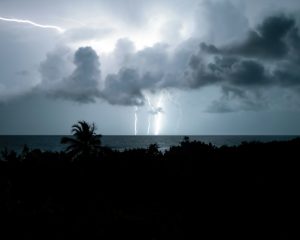The Caribbean and the Gulf of Mexico are frequently affected by hurricanes, which are among the most destructive natural phenomena on Earth. These regions face numerous hurricanes each year, and their vulnerability to such storms raises the question: why do so many hurricanes occur in these areas? Understanding the mechanisms behind hurricane formation and the specific conditions in the Caribbean and the Gulf of Mexico can help explain this phenomenon.
In this article, we will take a look into the scientific reasons why the Caribbean and the Gulf of Mexico are particularly prone to hurricanes. We will explore the geography, climate, oceanic conditions, and meteorological factors that make these regions ideal breeding grounds for hurricanes.
What Are Hurricanes?
Before diving into the reasons why hurricanes are so frequent in the Caribbean and the Gulf of Mexico, it’s important to understand what a hurricane is. Hurricanes are a type of tropical cyclone, which are intense storm systems characterized by strong winds, heavy rain, and low-pressure centers. In the Atlantic Ocean, these storms are called hurricanes, while in other parts of the world, they are known as typhoons or cyclones.
For a tropical cyclone to form, certain conditions must be met:
• Warm ocean waters (typically 80°F or higher)
• Moist air in the atmosphere
• Low wind shear, which allows the storm to organize and strengthen
• A pre-existing weather disturbance, such as a tropical wave or low-pressure system
When these conditions align, a tropical disturbance can develop into a hurricane, capable of causing widespread damage to coastal regions.
Why the Caribbean and Gulf of Mexico Are Hurricane Hotspots
There are several reasons why the Caribbean and the Gulf of Mexico are particularly susceptible to hurricanes. These include geographical location, sea surface temperatures, wind patterns, and the climate of the surrounding regions. Let’s examine these factors in detail.
1. Warm Sea Surface Temperatures
One of the most critical factors in hurricane formation is warm ocean water. Hurricanes derive their energy from the heat released when warm, moist air rises and condenses in the atmosphere. The Caribbean Sea and the Gulf of Mexico are known for their consistently warm waters, which provide the perfect environment for tropical cyclones to develop and intensify.
The waters in these regions often reach 80°F (27°C) or higher, which is the minimum temperature required to fuel a tropical cyclone. In fact, during the peak of the Atlantic hurricane season (from June to November), sea surface temperatures in the Caribbean and Gulf of Mexico can exceed 85°F (29°C), creating an abundance of energy for storm development.
Warm sea surface temperatures not only contribute to the formation of hurricanes but also play a significant role in determining the strength of these storms. Warmer waters can lead to more intense hurricanes, as seen with recent storms that rapidly intensify before making landfall in the Gulf of Mexico.
2. Geographical Location in the Tropics
The Caribbean and the Gulf of Mexico are located in the tropics, where hurricanes are most likely to form. Tropical cyclones typically develop between 5° and 30° latitude north and south of the equator, where the Coriolis effect—caused by the rotation of the Earth—helps spin storm systems and allows them to organize into hurricanes.
The Caribbean Sea and the Gulf of Mexico are situated well within this tropical zone, making them prime areas for hurricane formation. In addition, these regions lie within the Atlantic hurricane basin, which is one of the most active hurricane-producing areas in the world. This basin includes the Atlantic Ocean, the Caribbean Sea, and the Gulf of Mexico.
3. Proximity to the Intertropical Convergence Zone (ITCZ)
Another important factor in hurricane formation is the Intertropical Convergence Zone (ITCZ). The ITCZ is a region near the equator where the northeast trade winds from the Northern Hemisphere and the southeast trade winds from the Southern Hemisphere converge. This convergence creates a zone of low pressure, which is conducive to the development of tropical disturbances.
The Caribbean and the Gulf of Mexico are located relatively close to the ITCZ, particularly during the summer months when the zone shifts northward. As a result, tropical waves and disturbances that form within the ITCZ often move into the Caribbean Sea, where they have the potential to develop into hurricanes.
4. Tropical Waves
Tropical waves, also known as easterly waves, are another factor contributing to the high frequency of hurricanes in the Caribbean and Gulf of Mexico. These are disturbances in the tropical atmosphere that move westward from the coast of Africa across the Atlantic Ocean.
Many hurricanes that impact the Caribbean and the Gulf of Mexico begin as tropical waves over the eastern Atlantic. As these waves travel westward, they encounter the warm waters of the Atlantic and Caribbean, which can cause them to strengthen into tropical storms or hurricanes. The easterly winds that carry these waves from Africa to the Caribbean contribute to the development of storms during the hurricane season.
5. Low Wind Shear
Wind shear refers to the change in wind speed or direction with altitude. High wind shear can disrupt the formation of hurricanes by tilting the storm and preventing it from organizing. In contrast, low wind shear allows a storm system to remain upright and continue to grow in strength.
During the Atlantic hurricane season, wind shear is typically low in the Caribbean and Gulf of Mexico, especially in the months of August through October. This lack of wind shear allows tropical cyclones to develop and intensify more easily, making the region more susceptible to powerful hurricanes.
6. Moisture in the Atmosphere
Hurricanes thrive in environments with high humidity and moist air in the lower and middle levels of the atmosphere. The Caribbean and the Gulf of Mexico are characterized by high humidity levels during the hurricane season, providing the moisture necessary for tropical cyclones to develop.
The moist air in these regions helps fuel the convection processes within a storm, allowing it to grow and maintain strength. When dry air infiltrates a tropical storm, it can weaken or dissipate, but the consistently moist conditions in the Caribbean and Gulf of Mexico support storm development.
7. Cyclogenesis Favorability in the Gulf of Mexico
The Gulf of Mexico is a particularly favorable region for cyclogenesis, which is the process of hurricane formation. The Gulf is surrounded by land on three sides, which creates a semi-enclosed basin. This geography allows storms to intensify quickly once they enter the warm, shallow waters of the Gulf.
In addition, the Gulf of Mexico is relatively small compared to the open Atlantic Ocean, meaning that hurricanes have less space to weaken before making landfall. As a result, tropical storms and hurricanes that enter the Gulf often strengthen rapidly before striking coastal areas such as Texas, Louisiana, Mississippi, Alabama, and Florida.
8. Hurricane Season Timing and Patterns
The Atlantic hurricane season runs from June 1 to November 30, with the peak occurring between August and October. During this period, all the necessary ingredients for hurricane formation—warm sea surface temperatures, low wind shear, high humidity, and favorable wind patterns—are present in the Caribbean and Gulf of Mexico.
This seasonal pattern is driven by changes in global weather systems, such as the North Atlantic Oscillation (NAO) and El Niño-Southern Oscillation (ENSO), which influence the frequency and intensity of hurricanes in the Atlantic basin. For example:
• La Niña conditions are associated with lower wind shear and more frequent hurricanes in the Caribbean and Gulf of Mexico.
• El Niño conditions typically increase wind shear in the Atlantic, which can reduce the number of hurricanes in these regions.
9. Climatic Shifts and Global Warming
Climate change and global warming have contributed to the increasing intensity and frequency of hurricanes in recent years. Warmer ocean temperatures, rising sea levels, and changing wind patterns all influence the behavior of hurricanes in the Caribbean and Gulf of Mexico.
As global temperatures rise, sea surface temperatures in these regions are also increasing, providing even more fuel for hurricanes. In addition, climate change is causing more rapid intensification of storms, meaning that hurricanes can strengthen into powerful storms more quickly than in the past. This has been observed in recent hurricanes such as Hurricane Harvey, Hurricane Maria, and Hurricane Dorian, which underwent rapid intensification before making landfall.
10. Geographical Vulnerability of Coastal Areas
The geography of the Caribbean islands and the Gulf Coast of the United States makes these areas particularly vulnerable to hurricanes. Many Caribbean islands are small and densely populated, with limited natural barriers to protect against storm surge and flooding.
Similarly, the low-lying coastal regions of the Gulf of Mexico, including cities like New Orleans, Houston, and Tampa, are highly susceptible to hurricane-related flooding and storm surges. The flat terrain and proximity to the ocean exacerbate the impacts of hurricanes, leading to severe damage during major storms.
Conclusion
The Caribbean and the Gulf of Mexico are ideal environments for hurricane formation due to a combination of warm sea surface temperatures, tropical geography, and favorable atmospheric conditions. The region’s proximity to the Intertropical Convergence Zone, frequent tropical waves, and seasonal patterns all contribute to the high frequency of hurricanes. Additionally, climate change is making hurricanes more intense and frequent, posing even greater risks to the vulnerable coastal areas in these regions.
While hurricanes are a natural part of the climate system in the Caribbean and Gulf of Mexico, understanding the factors that contribute to their formation can help people better prepare for these powerful storms. By improving forecasting, disaster preparedness, and mitigation efforts, communities in these regions can reduce the impact of hurricanes and protect lives and property.




